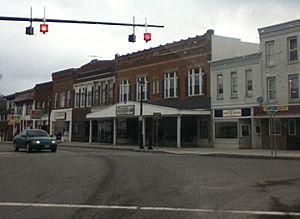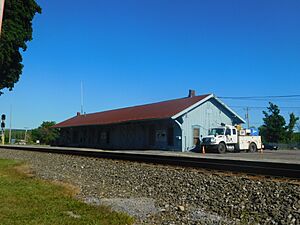Attica (village), New York facts for kids
Quick facts for kids
Attica, New York
|
|
|---|---|
 |
|
| Motto(s):
"Attica ... By Choice!"
|
|
| Country | United States |
| State | New York |
| Counties | Wyoming, Genesee |
| Towns | Attica, Alexander |
| Settled | 1802 |
| Incorporated | May 2, 1837 |
| Named for | Attica, Ancient Greece |
| Area | |
| • Total | 1.69 sq mi (4.38 km2) |
| • Land | 1.69 sq mi (4.38 km2) |
| • Water | 0.00 sq mi (0.00 km2) |
| Elevation | 981 ft (299 m) |
| Population
(2020)
|
|
| • Total | 2,450 |
| • Density | 1,448.85/sq mi (559.40/km2) |
| Time zone | UTC-5 (Eastern (EST)) |
| • Summer (DST) | UTC-4 (EDT) |
| ZIP code |
14011
|
| Area code(s) | 585 |
| FIPS code | 36-03001 |
| GNIS feature ID | 0942677 |
Attica is a village located in Wyoming and Genesee counties, in the state of New York, United States. In 2010, about 2,547 people lived there.
The village is found near the northern edge of Wyoming County. Most of Attica is within the town of Attica. However, the northern part of the village reaches into the nearby town of Alexander in Genesee County.
Contents
History of Attica
In 1802, a man named Zerah Phelps became the first European-American to own land in the Attica area. Before this, the land had been part of the territory of the Seneca Nation. The Seneca Nation is one of the Five Nations of the Iroquois Confederacy, a group of Native American tribes. After the American Revolution, many Seneca people were forced to leave New York.
Zerah Phelps built a gristmill, which is a mill for grinding grain. He was also the first business owner in Attica. By 1810, the settlement had grown into a small town. Some sicknesses caused settlers to move to higher ground. During the War of 1812, many people came to this area from Buffalo. Buffalo was an easy target for British attacks from the Great Lakes.
In 1837, Phelps' Settlement officially became the village of Attica. The village was named after a region in Greece.
In 1854, Dr. Orin Davis started a health center. People from all over the country came there for medical care.
In 1883, Eugene Norton created a special kind of cheese factory. It became famous for making "Pineapple Cheese." In 1918, the company's cheese molds and special recipes were sold to the Kraft Cheese Company. The Stevens family, a local family, was known for raising award-winning horses. One of their horses even won first prize at the World's Fair. Farming is still an important part of Attica's community and economy today.
As New York State decided to build more prisons, a group of citizens worked to get a state prison in the town of Attica. This was because there were not many job opportunities in the countryside. In March 1929, about 700 acres (2.8 km²) of land south of the village were bought for the prison. Construction began in October of that year. After two years, the first prisoners were moved to Attica.
Geography of Attica
The village of Attica is located in the northern part of the town of Attica in Wyoming County. Its exact location is 42°51′54″N 78°16′37″W / 42.86500°N 78.27694°W. The village also extends north into the town of Alexander in Genesee County. The village covers a total area of about 1.7 square miles (4.4 square kilometers), and all of it is land.
The Tonawanda Creek flows north through the middle of the village. This creek eventually flows into the Niagara River. New York State Route 98 runs through the village, following the west side of Tonawanda Creek. This road goes north 11 miles (18 km) to Batavia and south 27 miles (43 km) to Arcade.
New York State Route 238, also known as Main Street, goes through the center of Attica. It leads southeast 13 miles (21 km) to Warsaw and northwest 4 miles (6 km) to U.S. Route 20 in Darien. New York State Route 354 (West Main Street) goes west from Attica 33 miles (53 km) to Buffalo.
Attica's Climate
| Weather chart for Attica, New York | |||||||||||||||||||||||||||||||||||||||||||||||
|---|---|---|---|---|---|---|---|---|---|---|---|---|---|---|---|---|---|---|---|---|---|---|---|---|---|---|---|---|---|---|---|---|---|---|---|---|---|---|---|---|---|---|---|---|---|---|---|
| J | F | M | A | M | J | J | A | S | O | N | D | ||||||||||||||||||||||||||||||||||||
|
2.1
32
17
|
1.9
35
18
|
2.3
44
26
|
3
57
37
|
3.3
69
47
|
3.6
78
57
|
3.4
81
61
|
3.2
80
60
|
3.7
73
53
|
3.2
61
42
|
2.8
49
33
|
2.4
37
23
|
||||||||||||||||||||||||||||||||||||
| temperatures in °F precipitation totals in inches source: NOWData - NOAA Online Weather Data |
|||||||||||||||||||||||||||||||||||||||||||||||
|
Metric conversion
|
|||||||||||||||||||||||||||||||||||||||||||||||
The warmest weather in Attica usually happens in July and August. The highest temperature ever recorded nearby was 103°F (39°C) in July 1936. The lowest temperature ever recorded was -28°F (-33°C) in February 1934. Snow usually falls from November through March. The most snow recorded at one time was 23 inches (58 cm) in January 1966. In December 2012, the area had a lot of snow. About 15 to 17 inches (38 to 43 cm) of snow fell very quickly.
Population of Attica
| Historical population | |||
|---|---|---|---|
| Census | Pop. | %± | |
| 1840 | 800 | — | |
| 1850 | 600 | −25.0% | |
| 1860 | 1,098 | 83.0% | |
| 1870 | 1,333 | 21.4% | |
| 1880 | 1,935 | 45.2% | |
| 1890 | 1,994 | 3.0% | |
| 1900 | 1,785 | −10.5% | |
| 1910 | 1,869 | 4.7% | |
| 1920 | 2,015 | 7.8% | |
| 1930 | 2,212 | 9.8% | |
| 1940 | 2,379 | 7.5% | |
| 1950 | 2,676 | 12.5% | |
| 1960 | 2,758 | 3.1% | |
| 1970 | 2,911 | 5.5% | |
| 1980 | 2,659 | −8.7% | |
| 1990 | 2,630 | −1.1% | |
| 2000 | 2,597 | −1.3% | |
| 2010 | 2,547 | −1.9% | |
| 2020 | 2,450 | −3.8% | |
| U.S. Decennial Census | |||
Arts and Culture in Attica
Yearly Events
In 1957, the Attica Rodeo and Show Association was started. Every year, a rodeo is held at the grounds in Attica. This rodeo has been voted the best rodeo by the American Professional Rodeo Association.
Places to Visit
Several important places in Attica are listed on the National Register of Historic Places. These include the Exchange Street Historic District, the Augustus A. Smith House, and the U.S. Post Office. These places are important because they show the history and architecture of the area.
Education in Attica
The Attica Central School District (ACSD) serves most of the village. This includes the parts in both Wyoming and Genesee counties. The schools in the district are Attica Senior High School, Attica Junior High School, and Prospect Elementary. Sheldon Elementary is no longer used. A small part of Attica Village in Genesee County is part of the Alexander Central School District.
For higher education, students can attend Genesee Community College. Its main campus is just north of Attica in Batavia. Other colleges and universities nearby include Monroe Community College, State University of New York at Brockport, University at Buffalo, and University of Rochester.
State Institutions
The Attica Correctional Facility and Wyoming Correctional Facility are located south of the village in the Town of Attica. These are state prisons.
Notable People from Attica
- Parmenio Adams (1776–1832), a U.S. congressman from New York, lived here.
- Charles B. Benedict (1828–1901), a congressman from New York, lived here.
- George Gilbert Hoskins (1824–1893), a congressman from New York and lieutenant governor of New York, lived here.
- Harold C. Ostertag (1896–1985), a congressman from New York, was born here.
- James O. Putnam (1793–1855), a U.S. congressman from New York and New York state senator, lived here.
- James Edward Quigley (1854–1915), Bishop of Buffalo and Archbishop of Chicago, lived here.
- Leo Richard Smith (1905–1963), Bishop of Ogdensburg, was born here.
- Frederick C. Stevens (1856–1916), a New York state senator, was born here.
- Robert S. Stevens (1824–1893), a congressman from New York, was born here.
See Also
 In Spanish: Attica (villa) para niños
In Spanish: Attica (villa) para niños




